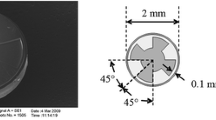Abstract
IN an investigation on the rate of spreading of liquids, including lubricants, (a) as a pool over horizontal surfaces, (b) between approaching and receding parallel flats, and (c) through capillaries, an unexpected resistance, associated with thin films extending beyond the boundary of the pools or from the menisci, has been measured in each kind of experiment. The angles of contact of water, benzene, n-hexane, etc., were small or zero, especially on surfaces wet with the respective liquids, and the large differences between the observed and calculated rates of movement in capillary ascent and fall could not be explained by the usual contact-angle hypothesis using the horizontal component γ cos θ instead of γ, where γ is the surface tension and θ the angle of contact. Graphs relating the rate of radial spread over a horizontal surface of a pool of liquid with the height or square of the height of the pool were found to be curvilinear with an intercept on the force axis1. Similarly, a graph relating the rate of movement of an index of liquid in a precision capillary tube and the force acting was found to be curvilinear even with a liquid such as n-heptane2. In Fig. 1 is shown such a graph for benzene in a scrupulously clean dry tube. The dotted-line portion of the graph was for slow movement which was non-Newtonian, the index of benzene ascending a tilted tube (indicated on the graph by a negative force) or passing along a horizontal tube spontaneously. When the tube was tilted down slightly from the horizontal, the rate of movement for small forces remained non-Newtonian and was reversible, the index recoiling when the tube was placed horizontally after movement. More regular movement occurred with forces greater than three dynes, but the rate was considerably less than that calculated from Poiseuille's equation of flow. The predicted rate corrected for flow reversal at the menisci is shown by the broken line.
Similar content being viewed by others
References
Bielak, E. B., and Mardles, E. W. J., J. Colloid Sci., 9, 233 (1954).
Calderwood, G. F. N., Douglas, H. W., and Mardles, E. W. J., Anal. Chem., 25, 935 (1953).
Calderwood, G. F. N., and Mardles, E. W. J., Proc. Phys. Soc., 67, 395 (1954).
Mardles, E. W. J., Brit. J. App. Phys., Supp., No. 1, 7 (1951).
Hirtz, J., and Bernard, R., J. de Chim. Phys., 48, 52 (1951).
Author information
Authors and Affiliations
Rights and permissions
About this article
Cite this article
BIELAK, E., CALDERWOOD, G. & MARDLES, E. Resistance to Flow of Liquids over Solids by Thin Films extending from the Edge of Pools or from Menisci. Nature 174, 1009–1010 (1954). https://doi.org/10.1038/1741009a0
Issue Date:
DOI: https://doi.org/10.1038/1741009a0
- Springer Nature Limited





